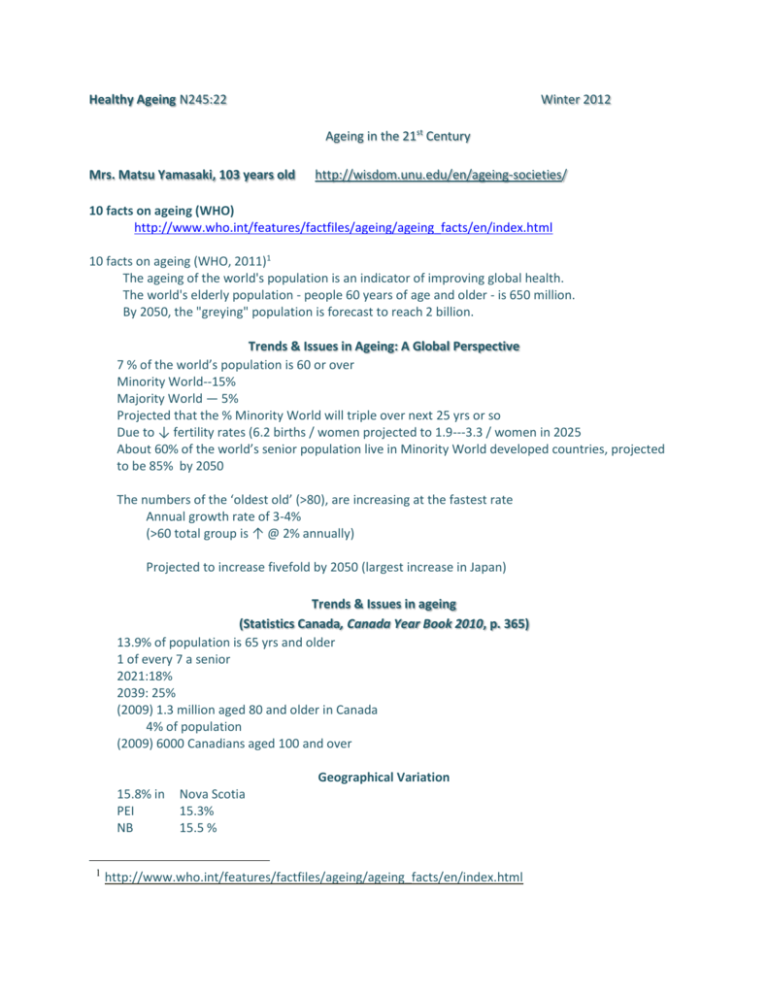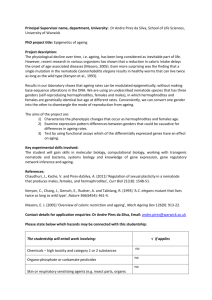ageing in the 21st century
advertisement

Healthy Ageing N245:22 Winter 2012 Ageing in the 21st Century Mrs. Matsu Yamasaki, 103 years old http://wisdom.unu.edu/en/ageing-societies/ 10 facts on ageing (WHO) http://www.who.int/features/factfiles/ageing/ageing_facts/en/index.html 10 facts on ageing (WHO, 2011)1 The ageing of the world's population is an indicator of improving global health. The world's elderly population - people 60 years of age and older - is 650 million. By 2050, the "greying" population is forecast to reach 2 billion. Trends & Issues in Ageing: A Global Perspective 7 % of the world’s population is 60 or over Minority World--15% Majority World — 5% Projected that the % Minority World will triple over next 25 yrs or so Due to ↓ fertility rates (6.2 births / women projected to 1.9---3.3 / women in 2025 About 60% of the world’s senior population live in Minority World developed countries, projected to be 85% by 2050 The numbers of the ‘oldest old’ (>80), are increasing at the fastest rate Annual growth rate of 3-4% (>60 total group is ↑ @ 2% annually) Projected to increase fivefold by 2050 (largest increase in Japan) Trends & Issues in ageing (Statistics Canada, Canada Year Book 2010, p. 365) 13.9% of population is 65 yrs and older 1 of every 7 a senior 2021:18% 2039: 25% (2009) 1.3 million aged 80 and older in Canada 4% of population (2009) 6000 Canadians aged 100 and over Geographical Variation 15.8% in PEI NB 1 Nova Scotia 15.3% 15.5 % http://www.who.int/features/factfiles/ageing/ageing_facts/en/index.html 2 NL 14.8 Maritime provinces has largest proportion of seniors # 10. AB 1% in Nunavut The evidence is clear.2 Older adults can live longer, healthier lives by staying socially connected, increasing their levels of physical activity, eating in a healthy way, taking steps to minimize their risks for falls, and refraining from smoking. There are real environmental, systemic and social barriers to adopting these healthy behaviours. Some relate to inequities as a result of gender, culture, ability, income, geography, ageism and living situations. Resources examined and discussed: Turcotte, M., & Schellenberg, G. (2007). A portrait of seniors in Canada 2006. Ottawa, ON: Statistics Canada. Nova Scotia. Department of Seniors. (2009). Seniors statistical profile 2009. Halifax, Canada: Author. International Perspective3 From 1950 to 2010, the share of Canada’s population aged 65 and older increased from 8% to 14% Japan recorded the highest proportion of people aged 65 and older among OECD countries in 2010, at 23%. Mexico recorded the lowest proportion at 6%. 2 Gender ratio globally majority of older adults = women 82 men : 100 women among oldest old 55 ♂ : 100 ♀ in the Majority World, the differences in life expectancy is less than in the Minority World Public Health Agency of Canada. (2009). A vision for healthy aging. A new vision (Chapter 3). Ottawa, Canada: Author. Retrieved from http://www.phac-aspc.gc.ca/ 3 Statistics Canada. (2011). Canada year book, p. 409 3 If desired, more info on Global issues and trends re. ageing4 Topics include: Married Living alone Labour force Retirement age, etc. Aging, Health & Nursing in the 21st Century Older Canadians (p. 7) ↓ in hospitalization for hip fractures improvements in functional health—particularly in older men in number of seniors who never smoked perceive themselves quite healthy—physically & mentally still face many complex health challenges assoc with aging quality of life tends to ↓ with age prevalence of chronic disease is more limited in activities than younger Canadians 7% need help with ADL 24% need help with IADL disabilities with age are at higher risk of injuries that will limit mobility & independence ~ 16% of Canadians >65 yr will experience some cognitive impairment Risk with age Strategic Priorities Healthy and successful aging The biological mechanisms of aging Cognitive impairment in aging Aging and maintenance of functional autonomy Health services and policy relating to older people Definitions Geriatrics - deals with the medical problems associated with aging as well as disease processes that affect older adults. It is a term with the medical focus, a sub-specialty of internal medicine Gerontology – study of the possible causes of aging and the physical, psychological and social results of the aging process Wellness: The best achievable balance between one’s environment, internal & external, and one’s emotional, spiritual, social, cultural, and physical processes” (Ebersole et al., 2008, pp. 45-46) What is old? [Chronological Definition] 65-74 75-84 85-95 >95 4 Young - old (middle) old Old - old Elite - old World Health Organization. (2007). Global age-friendly cities: A guide. Retrieved from http://www.who.int/ageing/publications/Global_age_friendly_cities_Guide_English.pdf 4 Types of Aging Chronological age Biological age Psychological age Social age “Active ageing is the process of optimizing opportunities for health, participation and security in order to enhance quality of life as people age.” 5 Emerging issues (WHO)6 Older persons and HIV/AIDS Abuse of older people Developing countries will become old before they become rich while industrialized countries became rich before they were growing old.7 Strategy: Age-friendly cities Housing Public transportation Well-lit streets that encourage walking Traffic lights with sufficient time Recreational activities Opportunities for income-generating activity Increase access to cost-effective procedures that help maintain activity Canadian Scene Gerontologic Nursing Association was constituted in 1985 Canadian gerontologic nurses wrote the first certification exam in 1999 (330 nurses passed) Certification is valid for 5 years CNA certification 16,260 RNs held CNA certification8 (p.2) gerontology is the specialty with the most certified nurses in Canada 2118 GNC(C) in Canada (2010) 126 in NS (6 in 2005) 5 World Health Organization. (2002). Active ageing: A policy framework. Retrieved from http://whqlibdoc.who.int/hq/2002/WHO_NMH_NPH_02.8.pdf 6 WHO. (2005). International plan of action on ageing: Report on implementation. Retrieved from http://www.who.int/gb/ebwha/pdf_files/WHA58/A58_19-en.pdf 7 WHO. (n.d.) Older people and Primary Health Care. Retrieved January 29, 2008 http://www.who.int/ageing/primary_health_care/en/index.html 8 CNA. (2011, Spring/Summer). Certification Bulletin. 11. 5 Gerontological Nursing Competencies & Standards for Practice (2010)9 Standard I: Physiological health Standard II: Optimizing Functional Health Standard III: Responsive Care Standard IV: Relationship Care Standard V: Health System Standard VI: Safety and Security Influence of Myths of Ageing on nursing ageism reduced healthcare services segregation of older adults from mainstream society nurse recruitment difficulties Implications for nursing education basic continuing practice research Theories of ageing Active Ageing: 10 The process of optimizing opportunities for health, participation and security in order to enhance quality of life as people age. The Ageing Process The ageing process is multifactorial & includes: Benign changes, such as graying hair Nonbenign changes, such as senescence Individualized ageing progression Modifiable changes related to lifestyle Normal or universal ageing processes Prominent Theories of Ageing Biological Theories Stochastic (Error) theories Nonstochastic theories Emerging biological theories Neuroendocrine control or pacemaker Caloric restriction (metabolic) Telomere function (genetic research) Biological Ageing Theories Stochastic (Error) Theories Wear-and-Tear 9 Canadian Gerontological Nursing Association. (2010). Gerontological nursing competencies and standards of practice. In course text, p. 16 Box 2-6. 10 WHO, 2002, Retrieved from http://whqlibdoc.who.int/hq/2002/WHO_NMH_NPH_02.8.pd 6 Cross-Link Free Radical & antioxidants Nonstochastic (Programmed) Theories Neuroendocrine-immunological Lifespan Development Approach Development is lifelong. Development depends on history and context. Development is multidimensional and multidirectional and involves a balance of growth and decline. Development is plastic rather than rigid. Sociological Ageing Theories Disengagement Activity Continuity Age-stratification Social exchange Modernization Symbolic interaction Sociological Theories of Aging Disengagement Theory Old age is a time when both the older person and society engage in mutual separation, as in the case of retirement. Sociological Theories of Aging Activity Theory Based on the belief that remaining as active as possible contributes to successful aging Sociological Theories of Aging Continuity Theory Continuity strategies are used to adapt to the changes of normal aging. People are motivated toward inner psychological continuity as well as outward continuity of social behaviour and circumstances. Continuity is a fluid concept and does not imply that people do not change; rather there is coherence and consistency of patterns over time. Sociological Theories of Aging Age-Stratification Theory Goes beyond the individual to the age structure of society Social institutions such as workplaces or families are partly organized by age, with segregation of older and younger people within these social institutions. Older people can be understood as members of specific “birth” cohorts (e.g., baby boomers), in which people of the same cohort have shared similar historical periods in their lives. Sociological Theories of Aging Social Exchange Theory Based on consideration of cost-benefit model of social participation Withdrawal or social isolation is the result of an imbalance in the social exchanges between older persons and younger members of society. 7 The balance determines the older person’s personal satisfaction and social support at any time. Sociological Theories of Aging Modernization Theory Attempts to explain social changes result in devaluing of both contributions of elders and of older people themselves The status, and therefore the value, of older people is lost in society when their labours are no longer considered useful. Sociological Theories of Aging Symbolic Interaction Theories Propose that the kind of aging process people experience is a result of interactions between the environment, the individual, and the meaning the person attributes to his or her activities Psychological Theories Jung’s Theory of Personality developmental Theories (Erikson & Peck) gerotranscendence Maslow’s Hierarchy of Human Needs*







